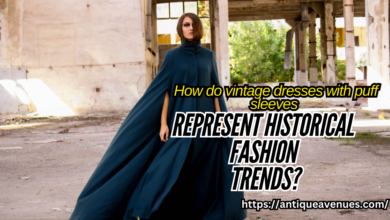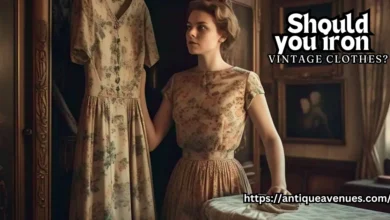How to iron vintage clothes?

The unique style, historical relevance, and artistry of vintage clothing make it valuable. These garments require more care, particularly in the area of ironing. Because they have weaker fibers and decorations vulnerable to heat, older textiles may be more brittle than modern versions. Their longevity and beauty, proper ironing practices are crucial. This post provides an in-depth guide on how to effectively and securely iron vintage clothing by addressing fabric types, preparation, ironing methods, options, and aftercare.
Understanding Vintage Fabrics and Their Sensitivities

Types of Fabrics Commonly Found in Vintage Clothing
Vintage garments can be made from a variety of materials, including:
- Natural fibers: Cotton, linen, silk, and wool, which are breathable but can become fragile with age.
- Early synthetics: Rayon, nylon, acetate, and other early plastics, which may react unpredictably to heat.
- Specialty fabrics: Velvet, lace, brocade, crepe, and garments with embellishments such as sequins, beads, or embroidery.
Why Vintage Fabrics Are Vulnerable
Many textiles deteriorate over time. The automatic renewal washings, contact with sunlight, and environmental variables may lead vintage textiles to lose their strength. They may also be more susceptible to pressure, moisture, and heat due to outdated manufacturing processes and dyes. It means that what suits modern textiles may harm antiques.
Importance of Identifying Fabric Content
Always check for original care labels, but if missing, perform a fabric test (such as a burn or water drop test) on a hidden seam to determine fiber type. This helps you choose the safest ironing method. When in doubt, use the gentlest approach.
Preparing to Iron Vintage Clothes
Inspecting the Garment
Before ironing, examine the garment for:
- Weak seams or fabric tears that may worsen with heat or pressure.
- Stains, like ironing, can set them permanently.
- Embellishments or trims that might be damaged by direct heat.
Repair or reinforce fragile areas if possible before proceeding.
Cleaning Before Ironing
Ironing over dirt or stains can make them permanent. Ensure the garment is clean and fully dry. Use gentle washing or spot-cleaning methods appropriate for the fabric type.
Assembling Essential Tools
Gather the necessary supplies:
- An iron with adjustable temperature settings, ideally with a “delicate” or “silk” mode.
- A press cloth (100% cotton or muslin) to protect the fabric from direct heat.
- A spray bottle with distilled water for gentle misting.
- A padded ironing board or a thick towel for a cushioned surface.
- Optional: Mini iron for small details, tailor’s ham for curved areas, or a mesh screen for added protection.
Pre-Ironing Preparation Techniques
Damping the Garment
The reduce wrinkles in the fibers, lightly spritz the fabric with distilled water. If there are a lot of wrinkles, wrap the wet clothing in a towel and leave it for a few hours before ironing.
Testing Heat Sensitivity
All the time, begin with the lowest heat setting and test on a discrete spot, such as the hem as well as the inside seam. When ironing the entire clothing, check for shine, melting, color changes, and other negative responses.
Setting Up the Ironing Area
The fresh, thick towel to cover the ironing board to provide more cushioning. All your devices should be easily accessible when you lay out your press cloth. In order to verify, you can keep a close eye on the fabric and work in a well-lit environment.
Step-by-Step Ironing Techniques for Vintage Clothes
General Ironing Order
To avoid re-wrinkling pressed areas, iron garments in this sequence:
- Collar
- Sleeves
- Back yokes
- Front yokes
- Side panels
- Skirt (from hem to waistband)
Ironing Flat Surfaces
- Lay the garment flat, smoothing out wrinkles by hand.
- Place the press cloth over the section to be ironed.
- Gently press the iron onto the cloth, using light pressure and continuous movement to avoid scorching.
- Lift and reposition the iron rather than dragging it, especially on delicate fibers.
Handling Details and Embellishments
- Avoid direct heat on sequins, beads, embroidery, or trims. Iron around these areas or use a mesh screen for extra protection.
- For pleats and gathers, position them carefully and use a press cloth to maintain shape without flattening.
- Use the tip of the iron or a mini iron for collars, cuffs, and small features.
Special Techniques for Hard-to-Reach Areas
- Use a tailor’s ham or rolled towel to support curved seams, darts, or sleeves.
- Work in small sections and check progress frequently to prevent accidental damage.
Fabric-Specific Ironing Guidelines

Cotton and Linen
- These fabrics tolerate higher heat and steam. Use a damp press cloth for best results.
- Always iron on the reverse side to prevent shine.
Silk
- Use a low heat setting (250°F-300°F/120°C-150°C).
- Always iron on the reverse side with a press cloth; never use direct steam, as it can leave water spots.
Wool and Rayon
- Prefer steaming, but if ironing, use low heat and a press cloth.
- Avoid pressing too hard to prevent shine or crushing fibers.
Synthetics (Nylon, Acetate)
- Use very low heat and test first to avoid melting.
- Use a press cloth and avoid steam unless the fabric care instructions specify it is safe.
Fabrics to Never Iron Directly
- Velvet, leather, vinyl, fur, faux fur, embossed or crepe textures, and any surface embellishments should not be ironed directly. Use steaming or leave unpressed.
Alternative Wrinkle Removal Methods
Steaming
The heat directly from a garment steamer held a few inches from the fabric, may eliminate wrinkles. Delicate synthetics, wool, rayon, and most trims and decorations work best with this technique.
Shower Steam
Hang garments in a steamy bathroom for gentle wrinkle release. This is especially useful for scarves, slips, and lightweight items.
Air Fluff Dryer Method
Place a lightly misted garment in a mesh bag and use the dryer’s air fluff (no heat) setting for a few minutes. Remove promptly to avoid new wrinkles.
Hanging and Gravity
When washing clothes, hang them immediately to reduce wrinkles. When using wire hangers, which can rip and deteriorate delicate fabrics, use padded hangers.
Aftercare and Storage
Cooling and Shaping
Allow garments to cool completely on the ironing board before moving or folding. This helps set the pressed shape and prevents new wrinkles.
Proper Storage
A fold and arrange your clothes with care if you want them to be smooth. The breathable clothes and bags should be stored in a dry, cool location, far from direct sunlight, to prevent fabric damage.
Ongoing Care
The eye out for damage and fresh wrinkles. When necessary, lightly steam your hair and refrain from over-ironing, which can weaken fibers and create shine.
Troubleshooting and Safety Tips
Common Ironing Issues
- Scorch marks: Stop immediately, blot with a damp cloth, and reassess your technique.
- Shine: Always use a press cloth and iron on the reverse side.
- Stubborn wrinkles: Try additional misting or switch to steaming.
Safety Precautions
- Never leave the iron unattended.
- Keep the iron moving to avoid burning.
- Avoid ironing over zippers, snaps, or plastic trims.
Conclusion
The right ironing of historical clothing requires patience, meticulous planning, and fabric-specific methods. The vintage clothing can be gently pressed with the right methods and safety equipment to maintain its charm and improve its longevity. Your vintage clothing will be an excellent addition to your collection of clothes for many years to come if you’re careful with it.





One Comment